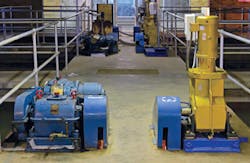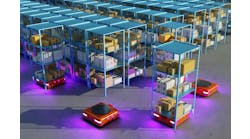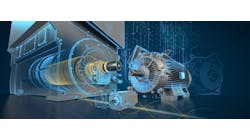However, their common mission is turning energy and electricity into mechanical power, and remembering this essential truth can free developers and users from their routine perspective to see the potential for motors and their supporting drives, controls and software to make new gains and be applied new ways. Of course, variable-speed/frequency drives have been the biggest advance in recent years, but they aren't alone.
More precise drives, better glass tempering
While more efficient motors get most of the attention, it's actually increasingly precise control that produces better-quality products.
For example, Glaston America Inc. in Mount Laurel, N.J., makes glass tempering ovens for large glassmakers, such as Cardinal Glass Industries (www.cardinalcorp.com) in Rockford, Ill., and one of its primary goals is precise speed control on its drives to prevent tiny scratches that can appear on improperly tempered glass. To secure a more precise and consistent drive solution, Glaston recently researched and settled on Control Techniques' Unidrive M drives from Emerson Industrial Automation.
"We first selected Unidrive SP drives because of their flexible programming and option cards for feedback and communications, but then migrated to Unidrive M701 because they better suited our needs," says Cliff Matukonis, senior process engineer at Glaston. "The integration of Profibus communications and application modules for increasing the drives' flexibility was also crucial in our decision."
Glaston deployed a total of 14 Unidrive M701 drives with SI-Profibus in its glass-tempering ovens—one for each roll section. Rollers pass glass through various oven sections to be treated, and then send it through a cooling section prior to packaging. Glaston also uses 14 Unimotor hd (highly dynamic) brushless servo motors from Control Techniques—one for each drive.
"The main benefit of Unidrive M701 is the precise speed control we can now exert on the oven rolls, which greatly reduces scratches and imperfections on the glass," adds Matukonis. "Furthermore, we now have more capability and flexibility, and found integration to the control system extremely straightforward. The system's design and interfaces, along with its diagnostics capability, also ensure ease-of-use for the machine's operators. Their option cards also give these drives flexibility. For example, we can bring two encoder signals from other motors into one drive. With minimal programming, we're able to have the drives follow either of these encoders with smooth ramps between the two different encoder speeds."
Better speed control, better flocculation
Even in applications that don't appear to need much accuracy, improved drive and motor control can make a big difference.
To remove contaminants from the 70 million gallons of water that its half million residents use each day, the Public Utilities Dept. in Toledo, Ohio, reports its Collins Park water treatment plant had used 12 mechanical positive infinitely variable (PIV) drives that were 75 years old to power fully submerged paddles on a 60-foot shaft in four large treatment basins. These paddles stir in added chemicals in a common process known as flocculation, which induces particles to collide and clump together into larger and more easily removable "floc."
"Our maintenance crews did a terrific job keeping the PIVs running, but it's becoming more and more difficult to get parts," says Andy McClure, plant administrator at Collins Park. "And because it's a mechanical system, we were stuck with whatever speed it was on when it shut down, which made it a little bit of an adventure when we started it back up. It was time for us to move to new technology."
Figure 1: Old mechanical, variable-speed drives (left) are replaced at Toledo's Collins Park water treatment plant by Baldor's Dodge Quantis right-angle helical bevel (RHB) reducer with a Baldor•Reliance Super-E premium efficient motor and VFD (right), which allow precise speed control of submerged paddles for flocculation in the plant's treatment basins.
Credit: Baldor
"These drives allow us to plug in and fine-tune the current, so the drive knows exactly what the motor needs," explains McClure. "So if there's a problem that causes an inrush of current, the drive will shut down to prevent damage, not only to the motor, but to all of the equipment. Protecting the system like this means a lot less maintenance." Also, based on current per-kilowatt-hour prices, the water treatment department estimates that Toledo will save an additional $7,569 per year in electricity when all 12 units are installed.
More power density, smaller frame size
While replacements can solve many motor and drive problems, sometimes new technologies can deliver more effective solutions.
To reduce motor failures on its two main PVC-U extruders for double-glazing products, Synseal Extrusions in Nottinghamshire, U.K., recently replaced 20-year-old servo motors that were needing increasingly frequent refurbishments, and tested and switched to new synchronous reluctance (SynRM) motors from ABB and Inverter Drive Systems.
"This was a standard, constant-torque extruder application, which was ideal for testing SynRM's capabilities," says Phil Nightingale, sales manager at IDS. "The servo motors were long and thin, and though they could have been replaced by squirrel cage motors, SynRM was a better fit because they offer more power for their size than conventional motors."
Offering up to 40% more power density than conventional induction motors, SynRM can be up to two frame sizes smaller than a conventional induction motor. It offers the high power density of an equivalent permanent magnet motor with the robustness of an asynchronous squirrel-cage motor. Also, because SynRM's rotor runs cooler than other technologies, its bearings run cooler, making the motor more reliable.
As a result, two 25-kW SynRM motors, together with matched ABB ACS880 drives, were installed on the extruders. IDS installed the drive, while Synseal installed the SynRM motors itself. This installation also included a force vent kit, foot mount and HTL encoder. Besides curing Synseal's reliability and obsolescence problems, SynRM also cut 20% off the running costs of the extruder, saving £754 per year on electricity.
"The motor and drive are now fitted as a permanent installation, and we have another machine to convert to this configuration later in the year," says Steve Scurrell, works manager for Synseal. "The main benefit to us is we now have much better availability of spare motors off the shelf, and know that we can keep our extruders running."







